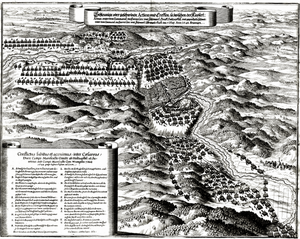Battle of Zusmarshausen facts for kids
Quick facts for kids Battle of Zusmarshausen |
|||||||
|---|---|---|---|---|---|---|---|
| Part of Thirty Years' War | |||||||
 |
|||||||
|
|||||||
| Belligerents | |||||||
| Commanders and leaders | |||||||
| Strength | |||||||
|
22,000
|
15,370–18,000
|
||||||
| Casualties and losses | |||||||
| 500 | 1,897–2,200 6 Guns |
||||||
The Battle of Zusmarshausen was a fight that happened on May 17, 1648. It was between armies from Bavaria and the Holy Roman Empire on one side, and a combined French and Swedish army on the other. The battle took place near Augsburg in modern-day Germany. The French and Swedish forces won this important battle.
The Imperial army was almost completely defeated. But a brave group of cavalry led by Raimondo Montecuccoli fought hard to protect their retreat. This allowed most of the Imperial army to escape.
Zusmarshausen was the last big battle of the Thirty Years' War fought in Germany. It was also the largest battle in the last three years of the war, even though not many soldiers died compared to other battles.
Why the Battle Happened
By the late 1640s, everyone involved in the Thirty Years' War was very tired. The war had lasted for three long decades. Peace talks had already started in 1646 in the cities of Münster and Osnabrück.
Even though peace talks were happening, the different sides kept fighting. They wanted to win more battles to get a better deal in the peace treaty. The Swedes especially wanted a big win against the Habsburg monarchy. This would help them gain land within the Holy Roman Empire. They also wanted to invade and take riches from Bohemia, a part of the Empire that hadn't seen much fighting yet.
Before the Fight
Four main armies were involved in the events leading up to Zusmarshausen. On one side, there was the Imperial army of 10,000 men. It was led by Peter Melander Graf von Holzappel. There was also a Bavarian army of 14,000 men. It was led by Jost Maximilian von Bronckhorst-Gronsfeld.
Opposing them were the Swedish army, with 20,000 soldiers, led by Carl Gustaf Wrangel. And a French army of 6,000 men. This army was led by Marshal Turenne. He was one of France's best generals at the time.
Wrangel started the 1648 campaign by marching south from Bremen. At the same time, Turenne moved north from Alsace. Their plan was to meet up near the River Main. Melander tried to stop them from joining forces. But his ally, Archbishop-Elector Ferdinand of Cologne, made things difficult. This forced Melander to retreat.
Wrangel and Turenne were able to join their armies. They then pushed southeast into Franconia. This made Melander retreat further into Bavaria, to Ulm. There, he met up with Gronsfeld's Bavarian troops.
In May, the French and Swedish army moved south into Württemberg. Then they turned east to face Melander and Gronsfeld in Bavaria. By this time, many Imperial-Bavarian soldiers had gotten sick or left the army. They now had only 16,000 men. This meant they were outnumbered by the French and Swedes.
Emperor Ferdinand III had told Melander not to risk his army. A big defeat could ruin the peace talks. So, Melander decided to retreat again instead of fighting. He ordered his troops to leave Ulm and march east towards Augsburg. To protect their retreat, he sent 2,000 Croatian cavalry. These soldiers, led by Raimondo Montecuccoli, were to fight a rearguard action. This happened at a bridge over the Zusam river, in the village of Zusmarshausen.
The Battle Begins
The battle started at 7 AM on May 17. Montecuccoli's troops in Zusmarshausen were attacked by the Swedish army's first wave. Montecuccoli held off the Swedes for an hour. Then he ordered his men to fall back east to Herpfenried village. There, they made another stand.
However, some French cavalry managed to get around Montecuccoli's position. This threatened to cut him off from the rest of his army. Melander himself rushed back to help his rearguard. In the fierce fighting, Melander was shot in the chest and died.
Montecuccoli managed to get his remaining men out of Herpfenried around noon. At 2 PM, he rejoined Gronsfeld and the main army. They had taken up a defensive spot on the east bank of the Schmutter river. Later that afternoon, the French army's first troops arrived. They made a few small attacks across the river. But they weren't strong enough for a full attack. Most of the French and Swedish army was still spread out along the road from Ulm. Night fell before more troops could arrive.
Under the cover of darkness, Gronsfeld left their defenses on the Schmutter. They completed their retreat to Augsburg. The Imperial-Bavarian army lost 1,582 soldiers killed or wounded. They also lost 315 prisoners, 6 cannons, and some of their supplies. Their commander, von Holzappel, was also killed. But the main part of their army managed to escape.
What Happened Next
Gronsfeld planned to defend at the Lech river against the enemy. But he heard a report that the Swedes were crossing the river on May 26. This report was greatly exaggerated. He thought his forces were too weak to push them back. An Imperial-Bavarian war council decided to retreat to Ingolstadt. Only Gronsfeld's second-in-command, Hunolstein, disagreed.
Maximilian I, Elector of Bavaria was very angry that Gronsfeld had given up so much of Bavaria without a fight. He had Gronsfeld arrested on June 3. Hunolstein became the temporary commander. The Imperial forces then put Ottavio Piccolomini in charge. The enemy's retreat allowed Wrangel and Turenne to move across southern Bavaria. They took riches from the area between the Lech and Isar rivers. The Swedes captured Freising and Landshut.
Even though the army shrank to only 10,000 men because of soldiers leaving, Hunolstein stopped Wrangel from crossing the strong Inn river. He reorganized the defense with Piccolomini. Piccolomini improved his men's spirits by bringing 3,100 new soldiers. He also used his own money to pay their overdue wages. Wrangel and Turenne could not advance further, so they started to pull their troops back.
Piccolomini went on the attack in July. He bothered the enemy without getting into a big battle. In August, Johann von Werth arrived from Bohemia with 6,000 more cavalry. The Bavarians put Adrian von Enkevort in command instead of Hunolstein. With 24,000 soldiers, Piccolomini's army was now about the same size as the Swedes and French. He slowly moved them out of Bavaria. He even won a small victory at Dachau on October 6. This cleared Bavaria of enemy troops between the Inn and Lech rivers.

However, the Swedes took advantage of weaker defenses in Bohemia. A second Swedish army, led by Königsmarck, surprised and took the castle and the Malá Strana district of Prague on July 25. Their siege of the Old and New Town continued even after the peace treaty was signed. The Peace of Westphalia was agreed upon on October 24. The Swedes failed to capture the larger Old Town of Prague. News of the peace treaty arrived on November 5, followed by Imperial help sent by Piccolomini.
Montecuccoli later became one of the Habsburg monarchy's most skilled generals. He and Turenne met again as opposing commanders in the Franco-Dutch War. This happened first in 1673 and then again in 1675.
Sources


